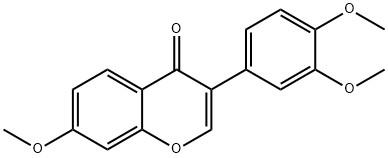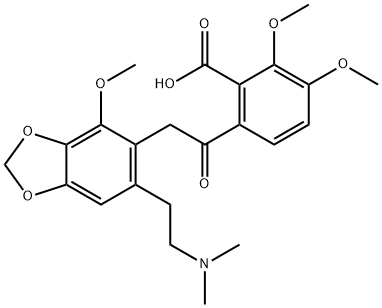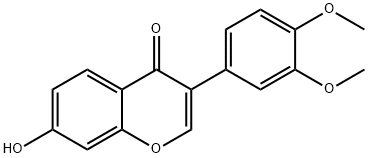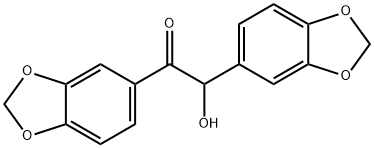4-HYDROXY-3-METHOXYPHENYLACETONE
- CAS NO.:2503-46-0
- Empirical Formula: C10H12O3
- Molecular Weight: 180.2
- MDL number: MFCD00130260
- EINECS: 219-704-6
- SAFETY DATA SHEET (SDS)
- Update Date: 2024-12-18 14:07:02

What is 4-HYDROXY-3-METHOXYPHENYLACETONE?
Chemical properties
Yellow Liquid
The Uses of 4-HYDROXY-3-METHOXYPHENYLACETONE
Volatile aromatic compound released from hard woods. It is often found in wine that has been aged in wood barrels contributing to the wine’s flavor profile. It is also released during combustion, giving flavor to smoked meats.
What are the applications of Application
4-Hydroxy-3-methoxyphenylacetone is a volatile aromatic compound
Properties of 4-HYDROXY-3-METHOXYPHENYLACETONE
| Boiling point: | 126-127 °C/0.3 mmHg (lit.) |
| Density | 1.163 g/mL at 25 °C (lit.) |
| refractive index | n |
| Flash point: | >230 °F |
| storage temp. | Sealed in dry,Room Temperature |
| solubility | DMSO (Sparingly), Methanol (Slightly) |
| form | Oil |
| pka | 9.90±0.20(Predicted) |
| color | Pale Yellow to Yellow |
| Water Solubility | Soluble in alcohol and water, 1.101e+004 mg/L @ 25°C (est.). |
| Sensitive | Air Sensitive |
| CAS DataBase Reference | 2503-46-0(CAS DataBase Reference) |
| EPA Substance Registry System | 2-Propanone, 1-(4-hydroxy-3-methoxyphenyl)- (2503-46-0) |
Safety information for 4-HYDROXY-3-METHOXYPHENYLACETONE
| Signal word | Warning |
| Pictogram(s) |
 Exclamation Mark Irritant GHS07 |
| GHS Hazard Statements |
H315:Skin corrosion/irritation H319:Serious eye damage/eye irritation H335:Specific target organ toxicity, single exposure;Respiratory tract irritation |
| Precautionary Statement Codes |
P261:Avoid breathing dust/fume/gas/mist/vapours/spray. P264:Wash hands thoroughly after handling. P264:Wash skin thouroughly after handling. P271:Use only outdoors or in a well-ventilated area. P280:Wear protective gloves/protective clothing/eye protection/face protection. P302+P352:IF ON SKIN: wash with plenty of soap and water. P305+P351+P338:IF IN EYES: Rinse cautiously with water for several minutes. Remove contact lenses, if present and easy to do. Continuerinsing. |
Computed Descriptors for 4-HYDROXY-3-METHOXYPHENYLACETONE
4-HYDROXY-3-METHOXYPHENYLACETONE manufacturer
Syn Finechem Laboratories Pvt Ltd.
1Y
Phone:+91-9848230784
Whatsapp: +91 9848230784
product: 2503-46-0 98%
Saasta Life Sciences
1Y
Phone:+91-9704665959
Whatsapp: +91 9704665959
product: (4-hydroxy-3-methoxyphenyl)acetone 98%
BASR Fine Chemicals Pvt. Ltd.
1Y
Phone:+91-9848230391
Whatsapp: +91-9848230391
product: 2503-46-0 98%
New Products
(S)-3-Aminobutanenitrile hydrochloride 4-Methylphenylacetic acid N-Boc-D-alaninol N-BOC-D/L-ALANINOL Tert-butyl bis(2-chloroethyl)carbamate 3-Morpholino-1-(4-nitrophenyl)-5,6-dihydropyridin- 2(1H)-one Furan-2,5-Dicarboxylic Acid Tropic acid 1-Bromo-3,5-Di-Tert-Butylbenzene S-2-CHLORO PROPIONIC ACID ETHYL ISOCYANOACETATE 2-Bromo-1,3-Bis(Dimethylamino)Trimethinium Hexafluorophosphate 4-IODO BENZOIC ACID 3-NITRO-2-METHYL ANILINE 1-(2,4-DICHLOROPHENYL) ETHANAMINE (2-Hydroxyphenyl)acetonitrile 4-Bromopyrazole 2-(Cyanocyclohexyl)acetic acid 4-methoxy-3,5-dinitropyridine 1-(4-(aminomethyl)benzyl)urea hydrochloride 2-aminopropyl benzoate hydrochloride diethyl 2-(2-((tertbutoxycarbonyl)amino) ethyl)malonate tert-butyl 4- (ureidomethyl)benzylcarbamate Ethyl-2-chloro((4-methoxyphenyl)hydrazono)acetateRelated products of tetrahydrofuran








You may like
-
 2503-46-0 1-(4-hydroxy-3-methoxyphenyl)propan-2-one 98%View Details
2503-46-0 1-(4-hydroxy-3-methoxyphenyl)propan-2-one 98%View Details
2503-46-0 -
 2503-46-0 98%View Details
2503-46-0 98%View Details
2503-46-0 -
 (4-hydroxy-3-methoxyphenyl)acetone 98%View Details
(4-hydroxy-3-methoxyphenyl)acetone 98%View Details
2503-46-0 -
 2503-46-0 98%View Details
2503-46-0 98%View Details
2503-46-0 -
 4-Hydroxy-3-methoxyphenylacetone CAS 2503-46-0View Details
4-Hydroxy-3-methoxyphenylacetone CAS 2503-46-0View Details
2503-46-0 -
 1975-50-4 98%View Details
1975-50-4 98%View Details
1975-50-4 -
 14714-50-2 (2-Hydroxyphenyl)acetonitrile 98+View Details
14714-50-2 (2-Hydroxyphenyl)acetonitrile 98+View Details
14714-50-2 -
 118753-70-1 98+View Details
118753-70-1 98+View Details
118753-70-1
Statement: All products displayed on this website are only used for non medical purposes such as industrial applications or scientific research, and cannot be used for clinical diagnosis or treatment of humans or animals. They are not medicinal or edible.